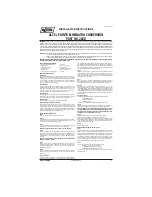
Insure nylon tubing in these areas has not melted or
collapsed.
Inspect all hose connections such as clamps and cou-
plings to make sure they are secure and no leaks are
present.
NOTE:
Often, fluid such as oil, power steering fluid,
and brake fluid are used during assembly plant opera-
tions to facilitate the assembly of hoses to couplings.
Therefore, oil wetness at the hose-coupling area is not
necessarily an indication of leakage. Actual dripping of
hot fluid when systems are under pressure (during
vehicle operation), should be noted before a hose is
replaced based on leakage.
NOTE:
Inspection of brake hoses should be performed
whenever the brake system is serviced and at every
engine oil change. Inspect hydraulic brake hoses for
surface cracking, scuffing, or worn spots. If there is any
evidence of cracking, scuffing, or worn spots, the hose
should be replaced immediately! Eventual deterioration
of the hose can take place resulting in a possibility of a
burst failure.
WARNING!
Worn brake hoses can burst and cause brake failure.
You could have an accident. If you see any signs of
cracking, scuffing, or worn spots, have the brake
hoses replaced immediately.
Brake Fluid Level Check
The fluid level in the master cylinder should be checked
when performing underhood services, or immediately if
the brake system warning light indicates system failure.
Clean the top of the master cylinder area before removing
the cap. Add fluid to bring the level up to the top of the
“FULL” mark on the side of the master cylinder reservoir.
Overfilling of fluid is not recommended because it may
cause leaking in the system.
Add enough fluid to bring the level up to the require-
ments described on the brake fluid reservoir. With disc
brakes, fluid level can be expected to fall as the brake
pads wear. However, low fluid level may be caused by a
leak and a checkup may be needed.
284
MAINTAINING YOUR VEHICLE
Summary of Contents for 2006 LX Magnum SRT8
Page 2: ......
Page 5: ...INTRODUCTION 5 1...
Page 8: ......
Page 82: ...82 UNDERSTANDING THE FEATURES OF YOUR VEHICLE...
Page 83: ...UNDERSTANDING THE FEATURES OF YOUR VEHICLE 83 3...
Page 84: ...84 UNDERSTANDING THE FEATURES OF YOUR VEHICLE...
Page 132: ...INSTRUMENTS AND CONTROLS 132 UNDERSTANDING YOUR INSTRUMENT PANEL...
Page 133: ...INSTRUMENT CLUSTER UNDERSTANDING YOUR INSTRUMENT PANEL 133 4...
Page 182: ...182 UNDERSTANDING YOUR INSTRUMENT PANEL...
Page 186: ...Operating Tips 186 UNDERSTANDING YOUR INSTRUMENT PANEL...
Page 214: ...214 STARTING AND OPERATING...
Page 248: ......
Page 263: ...6 1L ENGINE 6 1L Engine Compartment MAINTAINING YOUR VEHICLE 263 7...
Page 304: ......
Page 320: ......
Page 329: ...INDEX 10...
Page 343: ...NOTES...
Page 344: ...NOTES...
















































